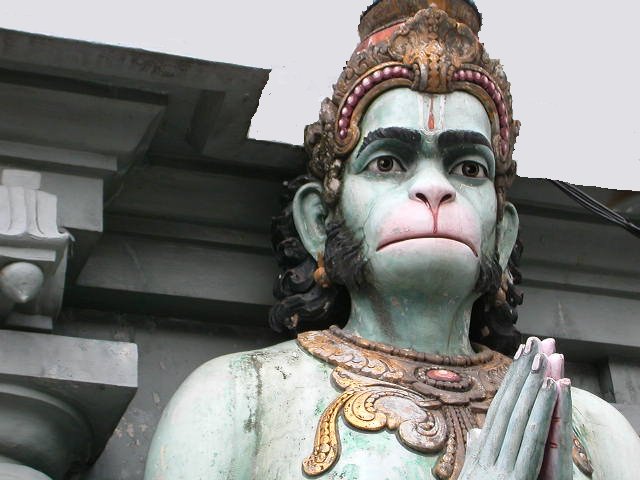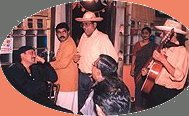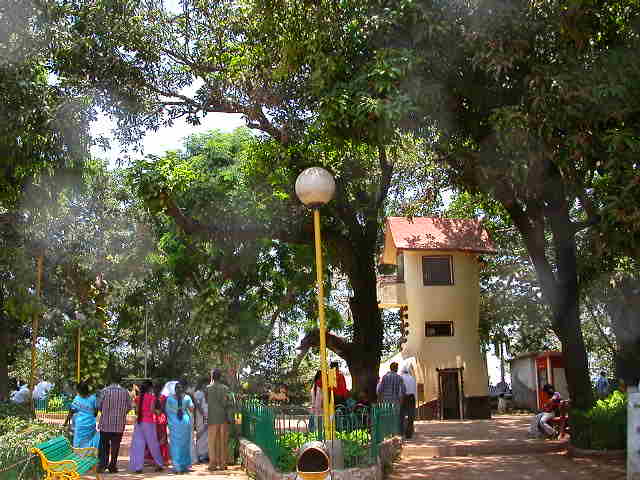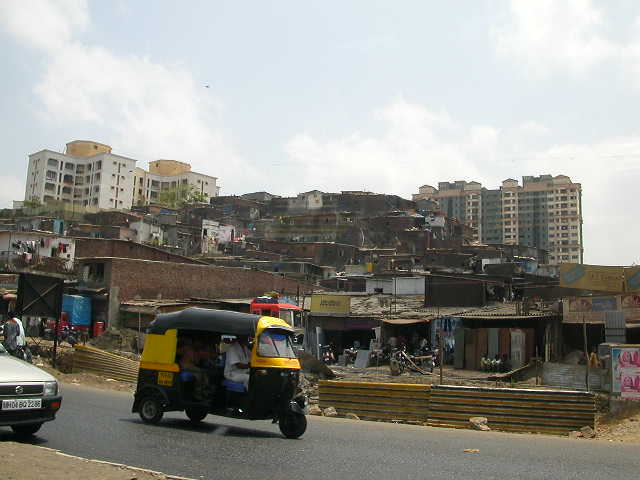b o l l y w o o d - f i l m s

BOLLYWOOD ---- The Dream Machine of India.
I HAVE WRITTEN PREVIOUSLY ABOUT HOW MUMBAI IS SUCH A GREAT PLACE TO EAT, WITH TRULY WORLDCLASS FOOD AT WORLDBEST PRICES, AND I HAVE WRITTEN ABOUT MUMBAI'S MANY COLORFUL HINDU TEMPLES, PARKS AND MUSLIM MOSQUES. I went on the record as saying: "it is in the kitchen department that this city really shines." Not to negate what I wrote there, but rather to transcend it -- Mumbai is indeed one food lover's paradise and the temples and markets and beaches are neat, but if there is one thing this city is really good at, that is making movies. I never used to be much of an Indian movie fan until I went to Mumbai, but now that I have been there, I have realised just how cool Bollywood cinema can be. Mumbai is the center of the Indian movie industry, and produces so many movies it has been nicknamed "Bollywood" (that's Hollywood plus the "B" from Mumbai's old name Bombay.) In my brief time in Mumbai in 2005 I was privileged to spend time on a Bollywood movie set, and even got offered a role! If you spend long enough in Mumbai, the same will happen with you. In a nutshell what I am trying to say is this: it is worth going to Mumbai just to check out the movie scene! I was surrounded by movies and movie music the whole time I was in Mumbai -- I especially liked surfing Indian cable TV with the staff at my hotel, bouncing through endless channels of subcontinental cinema magic! It sure beats Hollwood -- there are so many movies to choose from, representing the full gamut of Indian civilization! You could easily spend a contented lifetime watching your way through some of these marvels! And if you enough time to spare, you could also pick up a part-time job working as an extra in the Bollywood movie industry, and make a little cash on the side.
Welcome to the Mumbai Bollywood Cinema Guide. This website has a threefold purpose: to introduce the foreign tourist to Mumbai's thriving cinema scene, highlight the general nature of Bollywood cinema, its history and style and discuss both recent and classic films in specific; to let you know the best place to watch Bollywood cinema when in Mumbai, whether it be in a cinema or at your hotel on cable TV; and thirdly, I want to try to help aspiring foreigners to find acting work in Mumbai. To be honest, I hope one day to spend a little time working as an extra in Mumbai. But that dream is for tomorrow -- for today there is the Mumbai Bollywood Cinema Guide, which starts thus:

MONDAY, JUNE 11, 2007 ---- Disney Coming to India?
Here is a story I read in today's GUARDIAN newspaper, regarding
a new strategy by Disney Films, to penetrate farflung corners of the world: "A cheeky, speaking vegetable is just weeks away from bounding on to Chinese cinema screens. When The Magic Gourd opens at the end of this month, the Chinese-language film will mark a departure for Walt Disney and a step-change in its charm offensive in emerging markets.
The Magic Gourd is Disney's maiden co-production in China and if all goes to plan it will be the first of many locally made, Disney-branded films around the world. The creator of Mickey Mouse first made its way into China in the 1930s and already reaps a healthy profit from toy stores across the country. But the Magic Kingdom is no longer content with exporting shows, films and characters. Disney is now on a mission to woo even more families in countries such as Russia, India and Korea by giving them their specially created Disney tales.
"Thomas Staggs, chief finance officer, has earmarked $100m (£50m) for locally made films. That may seem like peanuts for a group with annual revenues of more than $34bn but Mr Staggs stresses it is a clear commitment to TV shows and feature films not made in the US.
"Unveiling the plans on a trip to London, he refused to divulge details of what will be made where. But he hinted at a string of indigenous films and television shows in both emerging and developed markets.
"Wherever it is - and he mentions "capabilities in South America" - the locally made, Disney-branded strategy is motivated by two business benefits.
"We make our brands more relevant to the local market. If you produce in-market it gives you the opportunity to produce something that is going to be resonant in a different way than the simple export programme," says Mr Staggs. "And we also give ourselves access to a broader marketplace. If you go round the world, local content can be anywhere from an important part of total media consumption to a dominant part. In some markets like China you can get much greater distribution of a film made in the country for that country..."
The article goes on to report: "In India, Disney's focus so far has been on television. Last year it became the country's leading children's television group after acquiring the teenagers' channel Hungama.
"In Latin America it has created local versions of TV shows such as Desperate Housewives. In Korea, it is trying to tap into the rapid evolution of mobile video. Russia also offers big opportunities in mobile because, like other emerging markets, there is a limited fixed-line infrastructure."

DREAM FACTORY ---- Whats In A Name?
WHAT'S IN A NAME? Bollywood superstar Amitabh Bachchan recently told 7Days that he hated the word "Bollywood" because "it makes it seem that the Hindi film industry is nothing but a
rip-off of Hollywood." Bachchan went on to say: "Actually, a lot of people are copying Bollywood movies. There is a man in Steven Spielberg's studio who makes it his sole business to watch Hindi films and remake them. Let me also tell you that George Lucas's "Star Wars" series is nothing but a take off on our "Ramayana" and "Mahabharatha" (both are Hindu mythological epics)."
I am not sure if that "Star Wars" allegation would hold up in court, but I agree with Bachchan's main thrust -- Bollywood movies are completely original, completely Indian, completely one-of-a-kind. Does any other civilization have cinema like this? And while Bachchan disdains the name Bollywood, it does help capture the moviemaking influence of this place. Just as Hollywood is the dream factory of the USA, Mumbai/Bombay is the dream factory of the Indian world. It has been this way for a long time.
A history lesson for you: Cinema arose in India in the early 20th Century, and then as now Mumbai/Bombay was the hub. In fact, Mumbai played host to the first movie screenings on the subconinent, in 1896, when the Lumiere Brothers' Chinematographe unveiled six soundless short films at Watson Hotel, Esplanade Mansion. Three years later Harishchandra Bhatvadekar (Save Dada) shot two short films and exhibited them under Edison's projecting kinetoscope.
India's first silent feature "Raja Harishchandra" was made by D.G. Phalke in 1913 -- it was all about Hindu mythology. All the roles were played by men as women were forbidden to act at the time. Incidentally, Hindu mythology has remained an essential component of Bollywood films right up to the present time. I am not the first to suggest that Bollywood cinema owes as much to the theatrical and epic style of the aforementioned "Ramayana" and "Mahabharatha", as it does to Western cinema tradition. Bollywood fits in neatly with the ranks of Hindu classics and the pantheon of Gods and Goddesses which inhabit the Hindu religion. By the 1920s the Indian film industry was pretty well established with a studio system in place. More than 1200 films were produced in this decade alone -- and this was still the silent era! In 1931 the fist talkie "Alam Ara" was produced, featuring dialogue in both Urdu and Hindi and extensive song and dance routines. Bollywood fans have loved song and dance ever since.

BOLLYWOOD STYLE.
SO WHY IS IT THAT HALF THE WORLD ADORES BOLLYWOOD, WHILE THE OTHER HALF SEEM TO DESPISE IT? In a wonderful story written by Suketu Mehta for the New York Times, the author claims: "The standard Western complaint about Bollywood movies is that they're melodramatic, but for those who love them, melodrama in the defense of entertainment is no vice. Take this explanation from a Dominican cabby in New York, who, along with his 14 siblings, grew up watching Hindi movies. He couldn't remember the title of a single one, but he did remember what he liked about them. "They have singing!" he exclaimed.
Every Bollywood film is a musical, with between 5 and 14 songs. No blockbuster special effects, no interplanetary spaceships, no lone American singlehandedly taking on armies of brown people -- just singing, and respect shown to mothers...
"In a Hindi movie, emotion is communicated through song, because song is more potent than dialogue. When there's overwhelming emotion -- love, hatred, heartbreak -- spoken words don't suffice. They have to be sung, and the singer has to be transported, on the wings of her song, to the Alpine meadows of Switzerland if she's falling in love (the Swiss Alps are a substitute for troubled Kashmir, the Indian honeymoon paradise) or to a temple in a thunderstorm if her mother is about to die."
To be honest, it is possible that the West and particularly American Hollywood cinema will eventually tire of its old action/realism formats, and incorporate a little Asian surrealism." Chinese kung fu cinema has already penetrated and transformed Hollywood. A Bollywood invasion could happen any time soon. In fact, there have already been some American films, which investigate this possibility.
The Guru, released in 2003 and directed by Daisy von Scherler Mayer, is one such film. THE GURU opens with a young Ramu Gupta (Jimi Mistry) in a Delhi movie theater, rejecting the extreme song and dance notions of the local Bollywood cinema for the more glamorous American film musical Grease. This transformative experience eventually leads Ramu to travel to New York, where he plans to launch a career as a dancing actor like his idol, John Travolta. Though things don't initially work out, he soon finds different kinds of success, both as "The Guru of Sex" (catering to an aimless socialite played by Marisa Tomei) and in wooing the woman he loves (Heather Graham), a porn actress with a heart of gold. While Ramu rejects the playfully surreal, over-the-top musical style of Bollywood, director von Scherler Mayer uses it to dual-edged effect in The Guru: at various times, the scenes set in America suddenly burst into rococo musical production numbers, simultaneously emulating and poking fun at the Indian cinema tradition. A final number even manages to fuse Bollywood techniques with a send-up of Grease, resulting in a humorous double homage.
So you see, Bollywood isn't so oldfashioned or lame as some might think. It might even be newfashioned. Styles always go around in a circle anyway.

MUMBAI CINEMAS.
I PROMISED YOU A LIST OF PLACES TO GO TO IN MUMBAI TO WATCH QUALITY (AND NOT SO QUALITY) BOLLYWOOD CINEMA. Well, here is that list. If you ever come to Mumbai, you should at least watch one movie in a proper cinema, since audience participation can often be more exciting than the actual content up on the screen. Watching Bollywood back at the hotel on cable TV -- preferably with a group of Indians around you -- can also be fun.
This is new multiplex cinema represents a trend in the Mumbai cinema scene. If you are willing to pay a little extra for your movie ticket, you can be pampered with a wealth of options -- such as recliner chairs, more space, etc. If only they offered complimentary massage and a shot bar, I'd be there.
On Anthony's Mirror the following news was reported: "Ajay Bijli who gave Indians the first taste of Multiplexes with his PVR chains, and set off a mini-multiplex boom is set to set-off another boom. Another first to his name, NO-Frills Multiplexes.
PVR cinemas will start a no-frills chain in small cities, starting from Latur and Aurangabad, names PVR talkies. He will do away Cushy seats, Plasma display, Neon-lighting, and central air-conditioning. Oh, they won't be selling 50 bucks pop corns either..."
For the complete guide to Mumbai cinemas, click here.
   
r e t r o + b o l l y w o o d
 I GOT THIS STORY FROM The Gulf Times IN THE PERSIAN GULF: IT IS ABOUT A NEW WAVE OF RETRO STRIKING BOLLYWOOD FILMS. I GOT THIS STORY FROM The Gulf Times IN THE PERSIAN GULF: IT IS ABOUT A NEW WAVE OF RETRO STRIKING BOLLYWOOD FILMS.
"A dearth of original storylines and a series of box-office flops with unconventional themes are pushing Bollywood producers to play it safe.
"A series of remakes of classics from the 1970s and 1980s are set to hit Indian theatres in the coming months.
"Superstar Shah Rukh Khan acts in a remake of 1970s hit film Don, which starred legend Amitabh Bachchan.
"Reigning beauty queen Aishwarya Rai takes the lead role in Umraojaan, which was a box-office hit and a critically acclaimed movie in the mid-1980s.
"'There is a shortage of original subjects in Bollywood today,' says Amod Mehra, film and trade analyst.
"Producers probably find safety in picking on something already touched earlier. We are going the Hollywood way ... they too went about remaking classic Hollywood films,' he says.
"Bachchan himself will star in a remake of his 1975 mega-hit Sholay, now to be directed by maverick Ram Gopal Varma, who produced a recent success with Bachchan again in Sarkar.
"Bollywood has seen a spate of unconventional films dealing with adultery, socio-political issues, period heroes, the supernatural, sci-fi, sex and urban lifestyles.
"'Unconventional films are gaining momentum but with a limited audience. It will take some time for them to entrench along with a typical commercial film,' says Mehra.
"In some cases fresh ideas exist but writers are not capable of converting these into good film scripts. Hence producers feel it is time to stick to a formula and remake old Bollywood classics.
"The trend began with this year's release of Parineeta, a winner in 1950s. The movie did average business.
"Paheli quickly followed in June. It was based on a re-imagining of Duvidha which was released in the early 1970s.
Now five other films, Sahib Biwi aur Ghulam, Arth, Don, Umraojaan and Sholay are in the works.
However the remake formula is a not guarantee of success.
In 2002, just one movie horror flick Raaz scored a real hit. In 2003, it was sci-fi theme Koi Mil Gaya, based loosely on Steven Spielberg's ET.
In 2004, sex and relationship-based flicks hit Indian screens, but one of the biggest hits was gang-biker movie Dhoom.
Industry analysts estimate the Hindi film industry suffered losses of Rs1.5bn ($34mn) in the first half of 2005 compared with Rs800mn ($18mn) for the same period last year.
Bollywood's losses amounted to Rs2.5bn ($57mn) for the whole of 2004, on top of losses of Rs3.2bn ($73mn) in 2002. In 2003 the industry was Rs2bn ($45mn) in the red.
Only 10 of the 105 films produced between January and June this year recovered their costs at the box office.
EVERY YEAR THRONGS OF INDIANS HEAD TO MUMBAI IN SEARCH OF FAME AND FORTUNE IN THE BOLLYWOOD MOVIE MACHINE. The competition for jobs and roles is so intense, it is only natural that a growing number of acting and film-making schools have grown up in Mumbai. At such schools real stars and legends of the Bollywood tradition form part of the curriculum, in the flesh, as live instructers and lecturers. Participation in real movie shoots adds to the hands on study ethic. For people looking to develop their skills and get a break in the India film industry, these schools could be your best shot forward. In the process, you could make connections which last you a lifetime.

ACTING AND FILM MAKING EDUCATIONAL FACILITIES IN MUMBAI.
Academy of Digital Film Making: Chinoy Mansion, First Floor, Block #2
(opposite St. Stephen's Church) Warden Road, Mumbai. Phone: 091-22-23676218.
Compufeild is a computer institute offering students considerable flexibility in designing their courses. Its Digital Film Making Academy offers the following courses: Certificate in Direction (Film and Video),
Certificate in Script Writing,
Certificate in Digital Cinematography,
Certificate in Digital Photograhy,
Certificate in Video & Film Editing (Avid Xpress DV),
Certificate in Visual effects (Combustion) and the
Certificate in Cell Animation.
Berkeley University India Internship.
Learn about film-making and other media in Mumbai, the home of Bollywood cinema. The course emphasizes the inner workings and logics of film and media workers in Mumbai and incorporates visits and lectures to media workers such as writers, producers, media company executives, actors, film directors, art designers, fashion choreographers...The program integrates lectures, readings, film screenings, field trips and internships on live film projects.
To gain practical experience, program participants are placed in an observational capacity with film professionals and gain first hand experience on the art of filmmaking. Mentoring professionals are chosen for their expertise, willingness and enthusiasm for teaching.
India is of course an amazing country to explore. This UC Berkeley internship allows students the chance to spend a few days on a real film set to get a behind-the-scenes view into the worlds of set designers, prop houses, casting directors, production executives, action directors, stunt masters, make-up artistes, fashion designers, lighting men, spot boys, music directors and other cast and crew.
Digital Academy Film & Television School.
Every Indian deep down wants to be famous at something these days, whether it is through excellence on the sporting field, or in front of a camera of some kind. There are also Indians who are desperatly seeking fame behind the camera, making movies or TV programs. The Digital Academy Film & Television is for people like them. At Digital Academy you can learn to ideate script, direct shoot edit, add required special effects, as well as record the sound & music under one roof. Digital Academy is in fact a complete school of filmmaking, a total immersion, and hands-on tool for learning the arts and crafts of filmmaking. The educators are industry professionals. In the realm of career assistance, Digital Academy has a special placement cell, which caters to placement and not just internship (eds note: Can you understand this Indian English?!)
Subjects covered: Script Writing, Cinematography, Non Linear Editing, Sound Engineering, Direction, Acting and Animation, and so on. This could be your ticket to success in Bollywood!
Film and Television Institute of India (FTII):Pune, Maharashtra State.
Located on 8.4 hectares of land in the heart of Pune, the FTII has built a reputation for itself as one of the best film schools in India. Over 100 resident students are provided access to top-of-the-line equipment and taught the art of film-making by a top-class faculty and a stream of personalities from the film industry, Indian and international. Students work in surroundings that have a history (the institute stands on the Prabhat Studios grounds), use Asia's largest indoor shooting set (a legacy of Prabhat), and have access to one of the best film archives in the world.
Imago School of Acting: New Delhi.
Another out-of-towner, but this facility might be of interest to readers, so I decided to include it. According to the information I have, Imago School of Acting offers several courses in performing arts and drama. It is also a theatre company for students, providing them with reallife dramatical experience.
The courses offered are: full time Diploma Course (3 months), part time Certificate Course (3 months) summer workshops for children and adults (May/June -- 1 month), the weekend Young Actors Club (6 months) and the drama teachers Training Course (6 months). Both Hindi and English are used in class.
Mumbai Academy of Movie and TV Arts: Behind Royal Challenge, Near HDFC Bank, Filmcity Road
Goregaon East, Mumbai, Maharashtra 400063. Phone: 91 9867726767. Web: www.mumbaifilmacademy.com.
One former student of this facility said: "I personally believethat Mumbai Academy is the most genuine and economical film teaching schools in Mumbai. All the faculty is professional and they know their job."
Courses offered here include diplomas of one, two and three years length, and short beginner and professional courses. The film formats used are MiniDV, Hi8, 3/4 Umatic, 16mm and 35mm. Editing systems covered are the
Avid Xpress/DV, Final Cut Pro and ProTools technology. The average tuition fees start from 25,000R. Foreigners are accepted and welcome at this school.

A REAL LIFE BOLLYWOOD SUCCESS STORY.
Contact the author Rob Sullivan at bunyarra@hotmail.com. Anticopyright February 2005.

|

